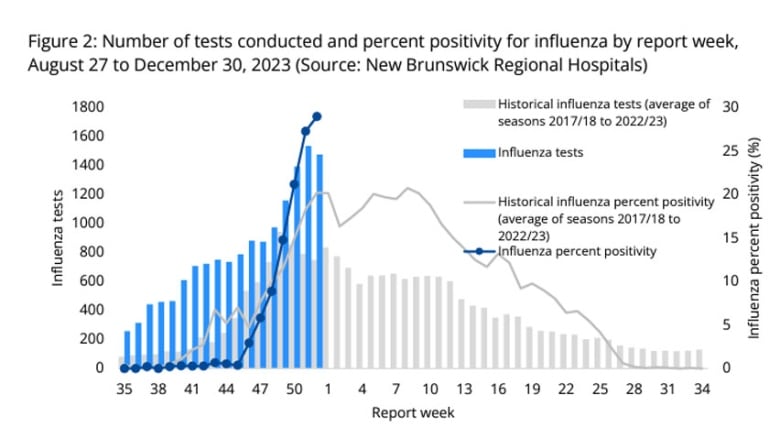
COVID-19 has killed 17 more New Brunswickers, including six over the holidays, while influenza has claimed nine lives. These are the first flu deaths of the season and they include a child under four, the latest data from the province shows.
Dr. Yves Léger, the province’s acting chief medical officer of health, held a rare meeting with reporters Tuesday because of the rise in respiratory illnesses.
He warned about the high number of strep bacterial infections, which are “at least double” their usual rates, some of them fatal.
Cases of respiratory syncytial virus, also known as RSV, are also climbing, and it may become a reportable disease in the province, Léger said.
“As you can imagine, with all those [respiratory illness] infections on the rise or peaking, a lot of people being sick, some of those will require medical care and some will require hospital admissions.
“This places additional pressure on our health-care system that’s already strained, all the while having to deal with this increased demand when their staffing illness rates are also likely higher.”
Acting chief medical officer of health Dr. Yves Léger says New Brunswick’s flu season is nearing its peak, with strep infections higher than in previous years.
Léger urged people to take steps to protect themselves and others, such as staying home when sick, masking in public places and handwashing.
Public Health also plans to step up its vaccination campaign messaging on social media over the coming weeks to try to encourage more New Brunswickers to get vaccinated, he said.
Only about 15 per cent of the eligible population has been vaccinated against COVID-19 so far this season and 25 per cent against the flu. “Those are not the best numbers. It leaves a lot to be desired,” said Léger.
“The respiratory illness season is here and it will still be around for a couple of months, so it will be beneficial to get vaccinated.”
About 100 group A streptococcal infections
Group A streptococcus, which causes illnesses such as strep throat and skin infections such as impetigo, “can in rare cases lead to more severe and sometimes life-threatening infections where the bacteria invades parts of the body, such as the blood, the deep muscles, fat tissues or the lungs,” he said.
The bacteria is spread by droplets from the nose and mouth.
New Brunswick recorded roughly 100 cases of group A streptococcal infections in 2023, as of the end of October, said Léger. The typical annual average over the past five years has been about 50, he said.
It’s a “concerning trend” being seen across Canada and in other countries, according to Léger — one that experts can’t yet explain.
“While the majority of our cases seem to occur in older individuals, we’ve seen increases in most of the other age groups as well,” he told reporters, without providing any specifics.
Asked specifically about deaths, Léger confirmed some people have died, but again did not provide further details.
Anyone with symptoms, including bruises or cuts that might be infected, is encouraged to seek medical care, he said. Once people have been on antibiotics for 24 hours they’re no longer contagious.
RSV activity may soon peak
Léger could not immediately provide any data on RSV cases, but did confirm “activity has been on the increase.”
He noted it’s showing some signs “that we are reaching peak activity.”
The common respiratory virus, which most children contract by the age of two, usually causes a mild illness with cold-like symptoms. But the Public Health Agency of Canada says it can be severe for people aged 65 and older, infants and people who are immunocompromised. It can result in hospitalization and even death.
Last fall and winter, New Brunswick recorded more than 1,500 RSV cases — the highest number in at least a decade.
“Last year was a bit of an outlier where we saw a very rapid, very high increase,” said Léger. “The overall picture we’re seeing so far this year is that of an RSV season that’s more typical, similar to what we’ve seen in pre-pandemic years.”

More than a year after Léger told reporters Public Health would look into following the lead of some other provinces and make RSV a reportable disease in New Brunswick, changes to the Public Health Act have been proposed, he said.
“That’s currently making its way through the machinery of government.” He could not provide any timeline.
If RSV was a reportable disease under the Public Health Act, “laboratory staff from all regional hospitals would have to submit the result to the regional public health team, where additional information would be collected about each case for analysis,” a Health Department spokesperson has said.
As it stands, the province simply inputs RSV test data into the national surveillance system weekly. No information about RSV-related hospitalizations or deaths, or breakdowns by ages are available.
Last week, Health Canada approved a new RSV vaccine for use in pregnancy to protect infants from birth to six months, and for seniors 60 and older. Léger could not say if or how soon New Brunswick might offer the vaccine. The province is awaiting recommendations from the National Advisory Committee on Immunization, he said.
COVID hospitalizes three children under 4
New Brunswick continues to see “modest levels of COVID-19] activity across the province, which overall seems to remain fairly stable across most indicators at this time,” according to Léger, referring to the latest Respiratory Watch report, which covers a three-week period, Dec. 10 to Dec. 30, instead of the usual one, because of the holidays.
Two of the people who died from COVID were between 45 and 64, while the other 15 were aged 65 or older, the report shows.
Their deaths raise the pandemic death toll to at least 989. Only confirmed cases who die in hospital are counted.
A total of 174 people were hospitalized for or with COVID during the three-week reporting period.
Among them were three children under age four, 12 people aged 20 to 44, 26 aged 45 to 64 and 132 aged 65 or older.
Eleven required intensive care.
35 outbreaks, 13 in nursing homes
Thirty-five lab-confirmed COVID outbreaks were declared — 13 in nursing homes and 22 in “other facilities.”
There were 516 new cases of the virus confirmed through PCR (polymerase chain reaction) lab tests over the three weeks. The positivity rate remained stable at between 10 per cent and 14 per cent, the report says.
There have been 129,097 XBB.1.5 COVID vaccines administered since Oct. 4, according to figures from the Department of Health.
Flu rates higher than average seasonal peaks
In addition to the child aged 0-4, the flu killed a person aged 45 to 64, and seven people aged 65 or older, the report shows.
Four of the nine deaths occurred between Dec. 24 and Dec. 30.
The flu sent 174 people to hospital during the three reporting weeks, including six children under four and five youth aged five to 19.
Twenty-three people were admitted to intensive care, one of whom is under 19.

The rate of lab-confirmed flu cases was significantly higher during the three reporting weeks than the average seasonal peak between 2017-18 and 2022-23, which is usually later in the winter, the data shows.
There were 1,143 new cases confirmed. Almost all were influenza A and two were influenza B.
These raise the total number of flu cases since the respiratory reason began on Aug. 27 to 1,501.
The positivity rate jumped from 21 per cent to 29 per cent over the three weeks, the report shows.
“There [are] signs that we are starting to perhaps plateau or reach that peak,” and will have a season similar to those pre-pandemic, said Léger. “We’ll see in the next week or two if that is confirmed.
The regional distribution of the flu cases includes:
- Moncton region, Zone 1 — 303.
- Saint John region, Zone 2 — 147.
- Fredericton region, Zone 3 — 249.
- Edmundston region, Zone 4 — 64.
- Campbellton region, Zone 5 — 44.
- Bathurst region, Zone 6 — 254.
- Miramichi region, Zone 7 — 82.
A total of 200,707 New Brunswickers have been vaccinated against the flu since Oct. 4.
